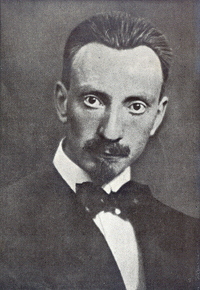Futurist and Dada poetry
Futurism is a modernist avant-garde movement in literature and part of the Futurism art movement that originated in Italy in the early 20th century. Futurist poetry is characterised by unexpected combinations of images and by its hyper-concision (in both economy of speech and actual length)
There were four forms of onomatopoeia that the Futurists advocated: direct, indirect, integral, and abstract. The first of these four is the usually onomatopoeia seen in typical poetry, e.g. boom, splash, tweet. They convey the most realistic translation of sound into language. Indirect onomatopoeia "expressed the subjective responses to external conditions".[9]
Integral onomatopoeia was "the introduction of any and every sound irrespective of its similarity to significant words".[7] This meant that any collection of letters could represent a sound. The final form of onomatopoeia did not reference external sounds or movements like the aforementioned versions of onomatopoeia. Rather, they tried to capture the internal motions of the soul.
Dada /ˈdɑːdɑː/ or Dadaism was an art movement of the European avant-garde in the early 20th century. Dada was born out of negative reaction to the horrors of World War I. The movement primarily involved visual arts, literature, poetry, art manifestoes, art theory, theatre, and graphic design, and concentrated itsanti-war politics through a rejection of the prevailing standards in art through anti-art cultural works.
 |
| http://upload.wikimedia.org/wikipedia/en/2/2b/Francis_Picabia%2C_Dame%21_Illustration_for_the_cover_ of_the_periodical_Dadaphone_n._7%2C_Paris%2C_March_1920.jpg |
 |
| http://upload.wikimedia.org/wikipedia/en/2/26/An_Anna_Blume.jpg |
My Poster
Paul Forrest Exhibition
On the 8th March I went to an Art Exhibition by Paul Forrest near the water front, it wasn't planned it just looked interesting so I popped in to have a look. And I found it really interesting that his work reminded me of the futurist and dad poetry from the simple shapes that were placed over the main subjects of his work.
paulforrest - website
 |
| http://en.wikipedia.org/wiki/File: Luigi_Russolo_ca._1916.gif |
Six groups in which he classified "noise-sound':
- Roars, Thunderings, Explosions, Hissing roars, Bangs, Booms
- Whistling, Hissing, Puffing
- Whispers, Murmurs, Mumbling, Muttering, Gurgling
- Noises obtained by beating on metals, woods, skins, stones, pottery, etc.
- Voices of animals and people, Shouts, Screams, Shrieks, Wails, Hoots, Howls, Death rattles, Sobs
- Screeching, Creaking, Rustling, Buzzing, Crackling, Scraping
I think that it is really interesting to know how far back 'Sound Art' goes as I would have thought it would be a more recent concept but its actually really rather old! about 100 years in fact.





No comments:
Post a Comment